Scientific Facts
| Crimson Name | Princess Parrot |
| Scientific Name | Polytelis alexandrae |
| Life Span | 30 years |
| Size | 18 inches |
| Habitat | -Sandy areas with sparse bushy growths and dry Casuarinas and Eucalyptus trees |
| Country of Origin | Australia |
Physical Description
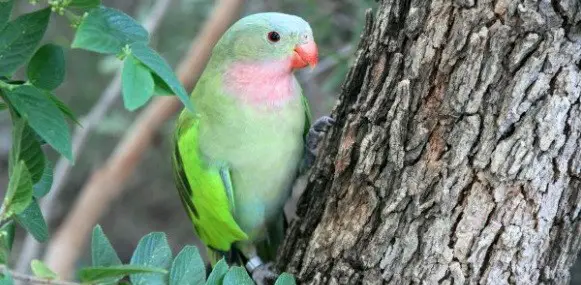
Colorful, dainty, and sweet, like a princess. The princess parrot is a bird named after Alexandra, Princess of Denmark, and the eventual Queen of the United Kingdom due to marriage to Prince of Wales Edward VII. This lovely parrot is native to Australia and is also known as Queen Alexandra parrot or parakeet, Alexandra’s parakeet, rose-throated parakeet, Princess of Wales parakeet, and spinifex parrot. This bird has a mostly-green body with a pink throat, bright green shoulders, and blue crown and rump.
The princess parrot has a medium-sized body, which is 34 to 46 cm long. It weighs from 110 and 120 grams. The feathers are mostly green except for a pink throat, blue crown, and bright-green shoulders. This also has a blue rump and a very long yet narrow tail.
Male princess parrots have longer tail feathers and have brighter colors than females. The males have a red beak while the female has a duller color and a grey crown. The male has a stunning orange iris while the female has lovely brown irises. You can also tell the male from the female from their wings. The males have a long and projecting wing extension from the end of the 3rd flight or primary wing on each side of the bird. This is called a spatula and is found only on mature princess parrots.
Colors
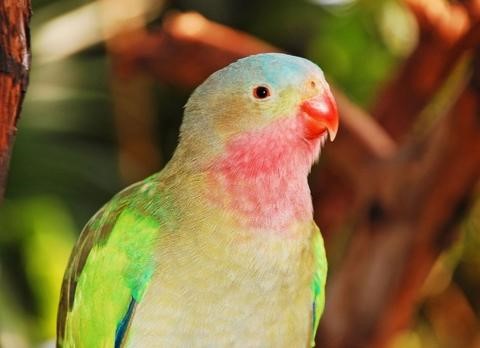
The princess parrot has all the dreamy colors put together. Some say that it has a royal appearance because of the way the different delicate colors are placed on different parts of its body.
The body is mostly green with yellowish tones along the chest, while brighter colors are found on the bird’s shoulders. The crown or the area above the head is smoky blue with slight tinges of purple. The throat and the area on top of the chest are pink. The rump is blue while the color tinges on the narrow tail are also blue.
Males have more pronounced colors compared to females. There are a few color mutations that have been observed in captivity. Nowadays, pet shops sell blue, lutino and albino princess parrots.
The three-color mutations are Lutino, Albino, and Blue. The natural color is green. You’ll find two kinds of blue, one bird with blue wings and another one with a bright blue head and wings.
Princess Parrot status
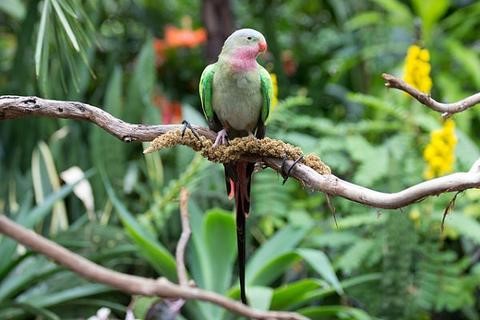
Based on the IUCN list of species, the princess parrot is classified as a Near Threatened species. This is possibly due to the destruction of the bird’s habitat, little knowledge about the species, and illegal pet trade.
Pet owners can help by not buying parrots from illegal retailers and sellers. Illegal sellers are likely to get parrots from the wild, and this is not going to help protect the declining population of the princess parrot. When the buying stops, the hunt for this parrot also decreases. There might still be hope to the already declining status of the princess parrot.
Lifespan
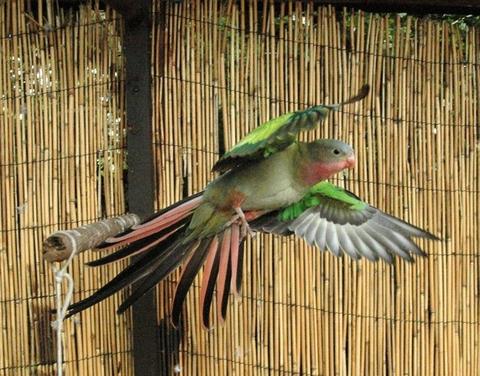
The princess parrot can live up to 30 years in captivity. There is no record of their lifespan in the wild. This parrot species can live this long because of the good care and attention of pet owners and also because of eating the right kind of food and the full attention the bird gets from their owners.
Natural Habitat
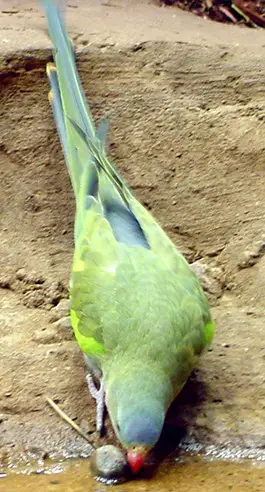
The princess parrot is one of the loveliest and is one of the most elusive as well. This species is found in the interior regions of Australia in the parts of Western and Central Australia. You’ll find this species from the Great Sandy Desert to the Goldfields.
The reason why this bird is very elusive is because of their habitat. They are nomadic and thus learn how to hide effectively from predators. The princess parrot prefers sandy habitats with only a few bushy plants and trees. They love to hang around casuarinas and eucalyptus trees.
These birds nest near bodies of fresh water. It is thought that there are only 7500 birds left in the wild as of today.
Perception and Communication
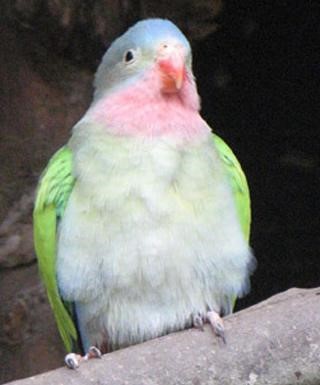
Princess parrots are chatty and noisy. They are also vocal and can imitate human speech. They have natural calls that consist of a series of shrill songs which can be melodic and sometimes very loud.
They can mimic speech and talk. You will be surprised by their ability to repeat common words with the best pronunciation and lifelikeness. When trained regularly, this parrot can expand its vocabulary and will repeat words with chatty mimicry.
People who have witnessed how the princess parrot speaks find it funny and very surprising as to what this bird can do. Usually, pet owners answer their bird’s words to imitate conversation, and this can make a really interesting trick.
The first time you get your parrot, it may not have an expanded vocabulary. It starts by talking to your pet using simple words. Introduce a new word and say it as elaborate as possible. Continue with one word and move only to another one once it can mimic the first word.
You can also place a speaker near its cage to play music or the radio. Remember to stay wholesome so your bird can also learn wholesome, non-embarrassing words that you can show off later.
Behavior
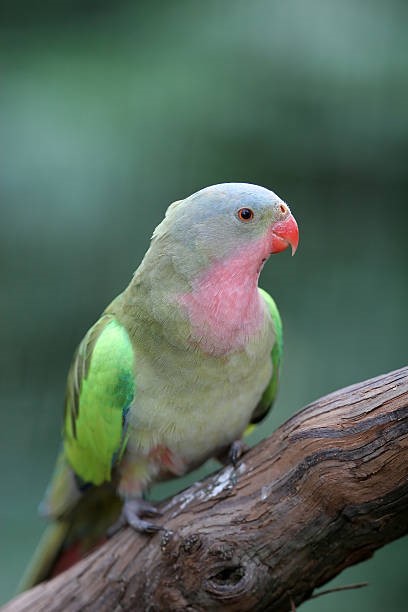
To get to know a princess parrot, you need to study its unique and charming behaviors:
Intelligent birds
The princess parrot is highly-intelligent, knows its owner, understands how to survive in the wild, and can assess danger being prey in the wild by birds of prey and larger animals. These are able to learn speech, and sometimes, they are better conversationalists than people.
Friendly
This is a very friendly bird, and usually, it will need only a few days to train, and soon, you’ll have a gentle, friendly, all-around bird that can become your companion for life. This bird is also friendly with other birds in its cage or with birds of the same species. In the wild, the princess parrot will hunt or forage for food in a large flock. This foraging party is loud, chatty, and very social.
Silly behavior
On top of being intelligent and friendly is the princess, parrot’s silly and naughty behavior. It can be trained to perform all kinds of fun tricks and may also naughtily take stuff from you and keep them.
Will bond to its owner and his family
Once you gained the trust of a princess parrot, it will remain loyal and well-bonded to you and your family. It can consider one owner but may also identify many people like neighbors and other family members. This means that the bird trusts you and the people around you at home.
Good at learning tricks
There are only a few parrot species that can perform tricks, and the princess parrot can endure daily training, training using treats, and interacting with you until it’s able to perform the trick. And like a dog, it will remember tricks for a long time. When you work with this bird daily, it can even learn complicated routines with ease.
Repeats common words
The princess parrot is very vocal and will easily learn a different word daily. But this depends on the owner. If you socialize with your pet and you use a consistent approach, it will gradually expand its vocabulary with ease. And aside from human speech, it can also learn how to mimic noise, tunes, whistles, and everyday sounds. All it takes is regular and patient training.
Funny, never a dull moment
This bird is the perfect companion. Just the sight of its colorful plumage, funny attitude, and unique talents can easily brighten your day. This is a good pet for seniors, single people, and also for a family with kids.
Protects their young
The princess parrot is a very protective parent. The male and female look for a nest that’s safe and secure for their young, usually selecting hollow eucalyptus or desert oak trees. This bird also chooses a site where food is abundant. This is very important so that the male or the female parrot won’t have to leave the nest too far just to look for food.
Easy to care for
The princess parrot may look delicate, but it is actually very easy to care for. It does not have a special diet or any particular kind of care requirement. It breeds well even in captivity, as well.
Nomadic in the wild
The princess parrot is nomadic. These birds move in small groups to breed and then disappear to the interior parts of the country. This nomadic and very elusive behavior is the reason why it’s one of the least understood parrot species. These parrots live to disappear in forests with spinifex, acacia, and eucalyptus. The parrots will depart from an area and sometimes won’t return up to 20 years.
Mobbing behavior
Another interesting behavior among this species is their mobbing behavior against their predators. If a parrot is alone, it will flee to the highest branch to avoid predators, but if it’s with a large group, the parrots will converge and try to scare the predator away.
Tame and may be approached
The princess parrot is one of the tamest parrots. Despite their elusive behavior, these parrots may be approached by humans even in the wild. These don’t bite or show any aggressive behavior. Some reports say these birds will even take food from humans.
Will be in small groups
Most of the time, princess parrots converge in small groups of up to 15 individuals. These birds will forage noisily and will look for food and nesting spots noisily as well. These behaviors are also common in other parrot species.
Development and Breeding

The female princess parrot will lay four to six eggs. Incubation time is three weeks, and only the female roosts on the eggs. Once this hatch, fledging is from two to three months. The hatchlings will leave the nest and fly with their parents to join the group. Parents will not return to the same nest and breeding area for many years.
The male becomes very aggressive during courtship, especially when approaching a female. The male can be seen in an upright position with his head feathers raised and his head bobbing. While his head moves up and down, his pupils will dilate and contract. His wings and tail will spread as he moves back and forth in front of his mate.
This parrot species is monogamous, just like other species. The breeding season for princess parrots starts September and ends in December. The parents make nests in holes located at the top of very high trees like eucalyptus branches. Usually, there is more than one nesting pair in a tree.
The nests are made of sawdust or wood shavings. The female line the nest with rotted wood to keep the nest warm and cozy for the chicks. When the nest is ready, the female will lay an average of four to six eggs.
The eggs will hatch approximately 3 weeks and then leave the nest after three weeks. These parrots will reach sexual maturity when they are three to five years old; however, some start breeding younger. The earliest recorded age of maturity is as early as seven months.
To find out if a bird is ready to breed, check its feathers. The bird will develop blue feathers on the front of the head or a crown. The rump will also develop blue feathers. Meanwhile, females will grow pinkish-mauve feathers along with the crown and gray feathers on its rump.
Princess parrot eggs incubate in approximately three weeks. Once the eggs hatch, they leave the nest after three weeks and will never return to the nest for many years. The male and female will likely take part in feeding and rearing their young, just like other parrot species.
Food and Diet
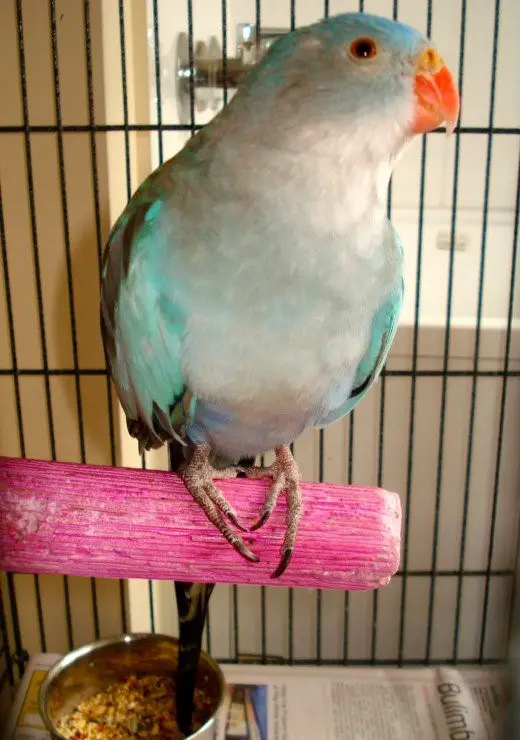
Princess parrots are herbivores with their natural diet composed of plants and plant parts like seeds, fruits, nuts, berries, and other green food. Common plants that these birds love to eat are eucalyptus and acacia.
Meanwhile, in captivity, the princess parrot should eat high-quality, commercially-prepared seed mixes. These food have sunflower, oats, safflower, millets, and hemp seeds. Aside from this food, you may also give your pet some fresh fruits, dried berries, vegetables, nuts, and jams.
Princess parrots will also need mineral supplements during the breeding season. The most important nutrient is calcium needed for bone and egg health. Also, parents should be provided with soft food as they need this to feed their chicks.
You may also feed princess parrots hemp seeds. These have complete amino-acids, omega 3 and 6 fatty acids and micronutrients to help your pet grow healthy. Hemp seeds contain high amounts of protein, which is important for good health. This protein is not commonly found in commercial bird feed mixes.
Captive Environment and Housing
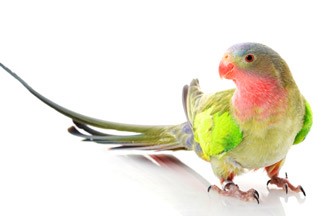
Princess Parrots need a large cage to remain. You also need a larger cage if you want to keep more parrots. Pick a spacious cage made of metal, or you can have one specially made. This must have a secure door. Keep this door locked and secure all the time.
This bird species need sturdy branches where it can perch. Use natural plants inside their cages where it can stay or sleep. Place cage furniture for your pet to play in; there are many types of cage furniture; just make sure that these are made of durable materials and won’t have pointed or jagged sides that may hurt your pet. Use ropes, natural perching blocks, wooden birdhouses, a medium-sized bowl for bathing, swings, and many more.
Use a shallow water basin and a container for food. The container must have a wide mouth so that your pet or pets can easily eat from it. Consider using two or more food containers if you have several birds.
Place the cage on top of a sturdy surface like a table, or you can use a cage with a stand. But no matter what, the cage must not be under direct sunlight and should be in an area that’s free from moisture.
The cage must have a good bedding material to absorb urine and smells. Coconut husks or wood shavings are good bedding materials. You may also use old newspapers, paper towels, or brown paper because these materials are readily available everywhere and are very easy to use.
When cleaning the cage, remove the bird and let it stay in a secure separate cage. Hose the cage down to remove stuck dirt and grime. Remove food and water containers and clean these separately with a good cleaning solution.
Use a natural cleaning product with disinfectant properties to remove dirt and smell. You can place natural plants inside the cage, but these must be cared for separately. Remove felled or dead stems and leaves. Water these days and take these out from the cage once in a while for some sun.
Health and Common Issues
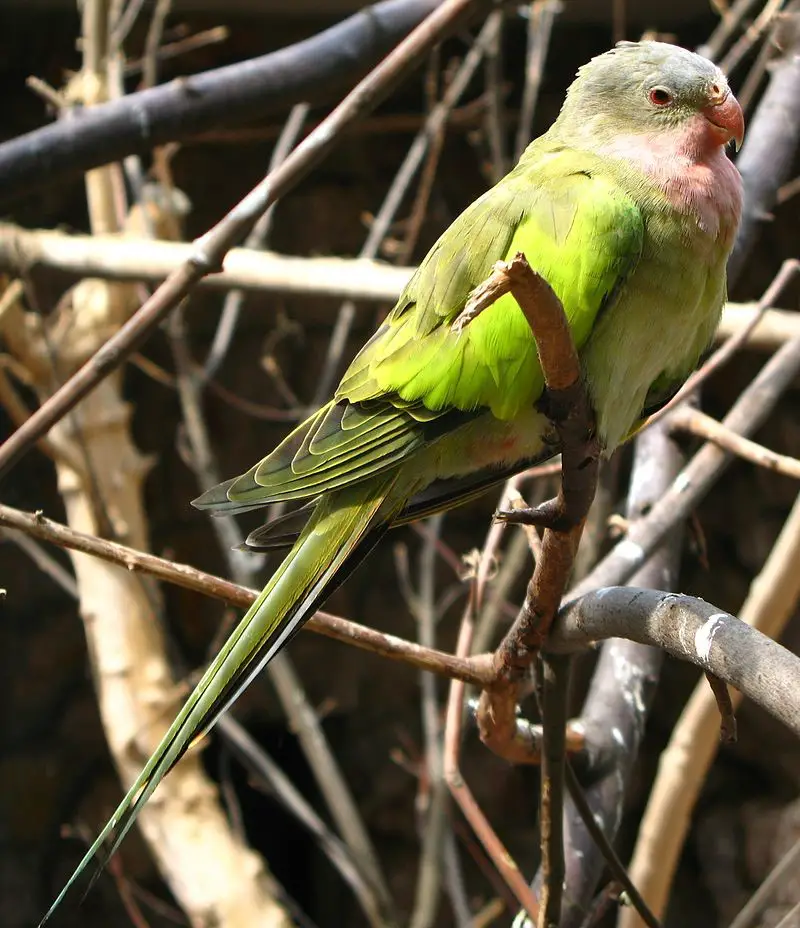
The princess parrot is a healthy and hardy breed but may be affected by the following health issues.
Parrot fever or psittacosis in birds
Parrot fever is an infectious disease common in most species of birds. This is spread by contact with the droppings of infected birds. Symptoms of parrot fever are restlessness, watery and green droppings, discharge coming from the eyes and nose, poor appetite, and lethargy.
Bird fever should be treated right away because this is contagious to humans. You must also wear proper protective equipment when feeding or cleaning pets suspected with parrot fever.
Malnutrition
Parrots with an imbalanced diet or have diets with insufficient nutrients could have malnutrition. Any illness may contribute to malnutrition. Symptoms of malnutrition are feather stress bars and dark feather colors. A malnourished bird will also suffer from weight loss, poor physical health, and will not breed.
You can avoid malnutrition by making sure that your bird is getting enough sunlight, especially when their cages are indoors. You may also use artificial birdcage lighting if you can’t take the cage out.
Also, be very careful in changing the bird’s diet. Usually, captive birds will refuse to eat and may starve themselves if you try to feed it new food. If you want to introduce a new food, feed it a little of the new food and still offer the old one. Offer the new food gradually. But if your pet won’t eat and it’s been a long time, and this is causing him his health, take it to the vet.
Pacheco’s disease in birds
Pacheco’s disease is a fatal viral disease caused by a type of herpes virus. The infected bird may spread this disease through contact with droppings and nasal discharge. The herpes virus may be dormant in a bird and activated during stress. Some common situations that stress birds are moving, the death of a partner, and breeding.
Symptoms of Pacheco’s disease include tremors, sinusitis, lack of energy, anorexia, green-colored droppings, and can even result in death. You can prevent the spread of this disease by placing suspected birds on quarantine. And despite being fatal to birds, this disease cannot be transferred to humans.
Avian polyomavirus in birds
Avian polyomavirus is an infectious disease in mammals and birds. This is a deadly disease that affects only young birds and passed on to other birds through droppings and touching.
Symptoms of avian polyomavirus are poor appetite, vomiting, diarrhea, swollen abdomen, and dehydration. If you overlook treatment, your pet can lose weight and may even die of complications. To prevent this disease, have your pet vaccinated against avian polyomavirus. Take note that this disease may be passed on to humans, so you must protect yourself by wearing gloves and a mask and have your pet checked right away.
Giardia in birds
Giardia is a parasitic infection that may be passed from one infected bird to another through cysts present in large numbers in the bird’s droppings. Giardia is caused by unclean water supply.
Symptoms of giardia include diarrhea, weight loss, dry and itchy skin, and constipation. And as soon as you spot these symptoms, take your pet parrot to the vet. Giardia may be passed to humans if their water supply is the same as the water supply of birds.
Monitor your parrot’s health and development. Check for any of the following symptoms: a strange appearance or stance, excessive plucking of feathers, trembling, poor balance, changes in behavior or attitude, and other very noticeable changes. Also, take note of any change in the bird’s droppings, breathing, eating, feathers, and feet must be consulted to an avian vet at once.
Preventive Care
To keep your princess parrot in perfect health, you must consider preventive care. A part of preventive care is checking your pet for any diseases or health issues so that these may be treated right away.
Your pet must undergo a complete physical examination every 6 to 12 months. An avian vet will check your pet and will prescribe nutrients, the right food, and any vaccinations necessary to ensure good health.
Your pet should have an annual fecal examination for yeast, parasites, and bacteria infestation. Vaccination for polyomavirus and routine blood testing should be done, especially for new pets.
Captive birds like the princess parrot must have some nail and wing trimming yearly or depending on your vet’s recommendations. Only an avian vet can get these done properly and carefully.
To avoid illness, clean your bird’s cage regularly. You must always remove droppings and wash the cage with a safe cleaning product. Clean the feeding and drinking dishes and the bird’s toys and cage furniture. By doing these, you will prevent the spread of illnesses, especially if you have more than one bird in a cage.
Availability – Where to Get One?

Princess parrots may be purchased from a breeder or an avian pet store online for $200 to $300 depending on the gender, age, color, and overall appearance of the bird. This is considered one of the most expensive species because of its lovely colors and its unique abilities. And if you plan to buy online, be prepared to pay more because of shipment and delivery fees.
But instead of buying a princess parrot and other exotic birds from a breeder, you may also check out birds available for adoption from bird adoption or bird rescue organizations. You may not find the parrot species of your choice, but you’ll be saving a parrot by giving it a new safe, and loving home.
How to Care for a Princess Parrot?
Princess parrots have similar needs like other parrots but also have unique requirements. So aside from providing basic care and taking it to the vet for medical attention, you must also be willing to commit to daily cage maintenance, feeding and one on one interaction.
Select an appropriately-sized cage that’s comfortable for the number of pets you have. The cage should be big enough to allow your bird to spread his wings without touching the sides of the enclosure. Add natural trees or plants to serve as perches and include safe bird toys.
Despite being easy to care for, handle your pet regularly. This will create a close bond between you and your princess parrot. Learn how to hold it and gain its trust before you start perching it on your arm and shoulders. This bird loves being petted and treated like a baby. This is why it’s suitable as a pet for seniors, singles, and families.
When it comes to feeding your princess parrot, give it appropriate bird food. You can use commercially-prepared bird food available in most pet shops and suppliers. To give it fruits and vegetables, choose organic produce only.
Always use a fixed feeding schedule and don’t feed too much to avoid being overweight and other health issues related to being overweight or obese. Always keep a bowl with clean water inside the cage and replace the water here daily.
Your pet princess parrot should be socialized as early as possible. This ensures that the bird will behave well, even if handled by other people. Also, consider taking your pet to the vet, preferably an avian vet for vaccinations, wing and nail clipping, and any medical condition.
If an avian vet is not available, you may consider a regular vet, but it’s best to consult an exotic bird specialist.
FAQs
How do princess parrots communicate with humans?
Princess parrots can mimic human words, but this does not mean that it understands what it says. It may communicate by shrieks, shrills, and whistles as it can be very noisy when excited or impatient but quiet when contented or tired.
Can you teach a princess parrot to sing or follow tunes?
Yes, you can teach a princess parrot to sing and whistle simple tunes. Pet owners do this by teaching their pet one word or one tune a day; they talk to their pet daily and let them listen to tunes until they get it. Only when it’s able to learn one word or tune should you proceed with another one.
Where do princess parrots make their nests?
Princess parrots make their nests in tall trees like eucalyptus and acacia. They will pick a tall tree with a hollow trunk to make their nests. It’s possible to find two or more parrots nesting in one tree.
Can you teach a princess parrot to whistle?
Yes, you can teach a princess parrot to whistle by whistling next to it. Your pet will follow through after only a few attempts. You’ll be surprised how easy and how exact the princess parrot will do this!
Will princess parrots play with other parrot species?
Yes, this parrot can play with other parrot species because of its warm and friendly nature. But when it feels threatened, or it does not want to socialize, it will stay in a tall area to perch there and remain still. It may also shriek loudly as well.
Can you keep more than one princess parrot in a cage?
Yes, you can keep more than one princess parrot in one cage. In fact, the more the merrier because this breed loves to socialize. But the most important thing is that you have a large cage to accommodate all the birds you want to keep!
What do princess parrots eat?
Princess parrots eat plants and all plant parts, including seeds, nectar, fruits, and stems. Other parrot species eat small insects and insect larvae but not the princess parrot, which is a herbivore.
Where do princess parrots live in the wild?
Princess parrots live in tall trees, especially in eucalyptus and acacia trees where they can find food and use the branches and leaves as shade from the hot sun. However, princess parrots are nomadic, so expect them to look for different homes where food is abundant from time to time.
Can you place a princess parrot on your shoulders?
Yes, you can train a princes parrot to perch on your shoulder, and it’s easy to do so too. You can do this by placing this first on your hand and then on your shoulders. Reward it after doing the trick.
Are princess parrots good parents?
Most parrot species are good parents in such a way that they build good and safe nests, keep their eggs warm and secure, and feed their young even after these have grown their feathers. Parrot parents usually will leave the nests with their young, to join the flock.
Can you incubate the eggs of a princess parrot?
Yes, you can incubate the eggs of a princess parrot but only in dire circumstances like when you discover an abandoned nest. And when in captivity and you notice the female eating her own eggs, you can take the eggs and incubate these yourself.
How do you make an incubator for your pet princess parrot?
Use a small basket and place old clothes in, create a nest by placing the clothes along the sides of the basket. Put the eggs in the middle and make sure to place it according to the position that you found it in its original nest. Use a strong incubator lamp to warm the eggs up; it will take around three to four weeks for the eggs to hatch.
Can you place the cage of a princess parrot indoors?
Yes, you may place the cage indoors, but make sure that this is near a window so your pets can still have access to sunlight and cool air. You may also use a lamp to warm the cage up in case there’s no window to let sunlight in.
Will a princess parrot escape from its cage?
Yes, this is a very bright bird, and it won’t hesitate to learn how to open its cage and escape. Use a strong lock, not something that’s easy to flip open, and also keep the birdcage door to keep predators out.
How can you tell if a princess parrot is happy?
A princess parrot is happy when it eats well, drinks water, and socializes with its mates. A threatened or stressed parrot will stay in one end of the cage and will avoid contact with other birds inside the cage and may not even eat.
Will a princess parrot bite?
No, this parrot is known for its friendly nature. It will even come up to humans and take food from their hands. As long as you socialize your pet with other birds and with you or other humans, it will be friendly and happy.
Will a princess parrot be aggressive to other birds?
No, princess parrots are not aggressive with other birds even if you keep this together with other parrot species.
Can you tame a princess parrot?
Princess parrots are already naturally friendly, but still, you need to tame this bird so it won’t be mischievous and cause trouble. Tame it by interacting with it daily or by petting, patting, and talking to it regularly.
Is a princess parrot a good first-time pet?
Yes, a princess parrot can be a good first-time pet, but this needs a dedicated owner who can train it to reach its true abilities. You must have time to train it and also to provide the best care.
Can you buy a princess parrot online?
Yes, you can buy a princess parrot online, usually sold by local traders and breeders. But make sure to select the safest and the most reliable breeder to buy this parrot from.
Is a princess parrot endangered?
The princess parrot has been classified as a near-threatened parrot species by the IUCN; therefore, you must never buy from illegal traders. Buy only from reliable breeders and those that breed parrots from captivity.
How young are princess parrots sold?
Princess parrots are sold as juveniles or newly hatched birds. The price may depend on the gender, the feather colors, and the size of the bird, and of course, you must consider the price of delivery and handling.
Can a princess parrot identify its owner?
A princess parrot is able to identify its owner and may sometimes obey only its owner. If you want your parrot to socialize with other people, let it play with your friends or family member.
Can you feed princess parrots commercially-prepared seed mixes?
Yes, you can feed it with commercially-prepared food as long as it’s free from toxins and chemicals which can harm your pet. You may also feed it organic products such as fruits and vegetables daily.


